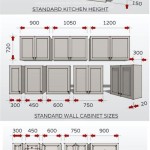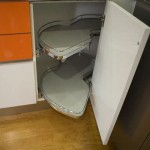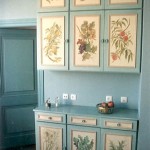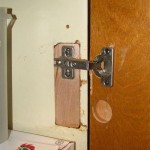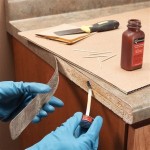Should I Wax My Kitchen Cabinets?
The decision of whether or not to wax kitchen cabinets is a multifaceted one, contingent on several factors including the cabinet's material, finish, desired aesthetic, and the homeowner's commitment to maintenance. Waxing kitchen cabinets, typically with paste wax containing beeswax or carnauba wax, is a traditional method of providing a protective layer and enhancing the appearance of wood finishes. However, its suitability and long-term benefits need careful consideration.
Before embarking on a waxing project, it is crucial to accurately identify the existing finish on the cabinets. Modern kitchen cabinets often have durable, factory-applied finishes such as polyurethane, lacquer, or conversion varnish. These finishes are designed to be water-resistant, stain-resistant, and relatively low-maintenance. Applying wax to these surfaces may not provide any significant benefit and, in some cases, could even detract from their appearance or make future refinishing more difficult.
Older cabinets, particularly those with shellac, varnish, or painted surfaces, may be more amenable to waxing. Waxing these finishes can offer a degree of protection against moisture, fingerprints, and minor scratches. It can also impart a subtle sheen and enhance the depth of the existing color. However, even with these surfaces, it's important to proceed with caution and test the wax in an inconspicuous area before applying it to the entire cabinet.
The primary purpose of waxing is to provide a sacrificial layer of protection. This means that instead of the underlying finish being directly exposed to wear and tear, the wax layer absorbs the impact. While this can be beneficial in the short term, it also necessitates regular reapplication of the wax to maintain the protective barrier.
The process of waxing involves several steps. The cabinets must first be thoroughly cleaned to remove any dirt, grease, or existing buildup. A mild detergent and water are usually sufficient for this purpose. Once the cabinets are clean and dry, a thin, even layer of wax is applied using a soft cloth or applicator pad. After allowing the wax to dry for the recommended time, it is buffed to a shine using a clean, lint-free cloth. This process can be time-consuming and labor-intensive, particularly for a large kitchen with numerous cabinets.
Understanding the Benefits of Waxing
One key benefit of waxing is the potential for enhancing the aesthetic appeal of certain finishes. Wax can add a subtle sheen and depth of color to older cabinets with shellac, varnish, or painted surfaces. This can give the cabinets a richer, more luxurious appearance. The wax also helps to fill in minor imperfections and scratches, making them less noticeable. However, it is important to note that the level of sheen achieved will depend on the type of wax used and the amount of buffing applied. Some waxes produce a high gloss, while others create a more matte finish.
Waxing can also provide a degree of protection against moisture and fingerprints. The wax layer creates a barrier that prevents water from penetrating the underlying finish, which can help to prevent water spots and damage. It also makes it easier to wipe away fingerprints and smudges, keeping the cabinets looking cleaner for longer. However, it's crucial to understand that wax is not a waterproof sealant. It will not protect against prolonged exposure to water or harsh chemicals.
For cabinets with distressed or antique finishes, waxing can help to preserve the character of the finish. The wax can be applied to highlight the existing imperfections and add to the overall aged appearance. It can also help to prevent further deterioration of the finish. However, it's important to use a wax that is specifically designed for antique finishes, as some waxes can contain ingredients that can damage delicate surfaces.
Assessing the Drawbacks of Waxing
Despite the potential benefits, waxing also has several drawbacks that need to be considered. One of the main drawbacks is the ongoing maintenance required. Wax is not a permanent finish and will eventually wear away over time, particularly in high-traffic areas such as around the handles and knobs. This means that the wax needs to be reapplied regularly, typically every few months, to maintain the protective layer and aesthetic appeal. This can be time-consuming and labor-intensive, especially for individuals with busy schedules.
Another drawback is the potential for wax buildup over time. If wax is not applied thinly and evenly, it can accumulate in corners and crevices, creating a sticky and unsightly residue. This buildup can be difficult to remove and may require the use of solvents or specialized cleaning products. It can also attract dust and dirt, making the cabinets look even dirtier.
Waxing can also make future refinishing more difficult. If you decide to refinish your cabinets in the future, the wax will need to be completely removed before any new finish can be applied. This can be a challenging and time-consuming process, as wax is resistant to many common solvents. Failure to remove the wax completely can result in a poor-quality finish that is prone to chipping, peeling, or cracking.
Furthermore, some waxes can yellow or darken over time, especially when exposed to sunlight. This can alter the appearance of the cabinets and may not be desirable. It's important to choose a wax that is specifically formulated to resist yellowing and darkening. Natural waxes like beeswax are generally less prone to yellowing than synthetic waxes.
Considering Alternatives to Waxing
Given the potential drawbacks of waxing, it's worth exploring alternative methods of protecting and enhancing the appearance of kitchen cabinets. One popular alternative is to use a specialized furniture polish or cleaner that is designed for the specific type of finish on the cabinets. These products often contain ingredients that help to protect the finish from moisture, fingerprints, and scratches, without the need for regular waxing. They are also typically easier to apply and maintain than wax.
Another alternative is to apply a clear coat of polyurethane or lacquer. These finishes provide a durable, long-lasting layer of protection that is resistant to water, stains, and scratches. They are also relatively easy to clean and maintain. However, applying a clear coat requires more skill and equipment than waxing, and it may be necessary to hire a professional to ensure a high-quality finish. Also, applying a clear coat does permanently alter the original finish of the cabinet, possibly impacting its value if it is antique.
For cabinets with already durable factory-applied finishes, simply maintaining a regular cleaning schedule may be sufficient. Use a mild detergent and water to remove any dirt, grease, or spills. Avoid using harsh chemicals or abrasive cleaners, as these can damage the finish. A microfiber cloth is ideal for cleaning cabinets, as it is gentle and effective at removing dirt and grime.
The decision of whether or not to wax kitchen cabinets ultimately depends on a careful assessment of the cabinets' existing finish, the desired aesthetic, and the homeowner's willingness to commit to ongoing maintenance. While waxing can offer certain benefits, it also has several drawbacks that need to be considered. Exploring alternative methods of protecting and enhancing the appearance of kitchen cabinets is always a worthwhile endeavor.
Testing the wax in an inconspicuous area before applying it to the entire cabinet is a critical step. This allows you to assess the wax's compatibility with the finish and to determine whether it produces the desired effect. If the wax causes any discoloration, streaking, or other undesirable effects, it should not be used on the cabinets.
Finally, it is always recommended to consult with a professional furniture refinisher or cabinet maker before waxing your kitchen cabinets, especially if you are unsure about the type of finish or the best way to care for it. A professional can provide expert advice and guidance, helping you to make the best decision for your cabinets and your home.

Refreshing Worn Wood With Briwax

Chalk Painted Kitchen Cabinets Two Years Later Our Storied Home

The Ultimate Guide To Cabinet Care Doors N More

Liming Wax On Oak Cabinets

How To Update Oak Cabinets With Briwax

Chalk Painted Kitchen Cabinets 2 Years Later Our Storied Home

How To Clean Prep Wood Kitchen Cabinets Before Painting Do Dodson Designs

How To Paint Kitchen Cabinets Without Sanding Or Priming

Painting Oak Cabinets White An Amazing Transformation

Refreshing Worn Wood With Briwax
Related Posts

